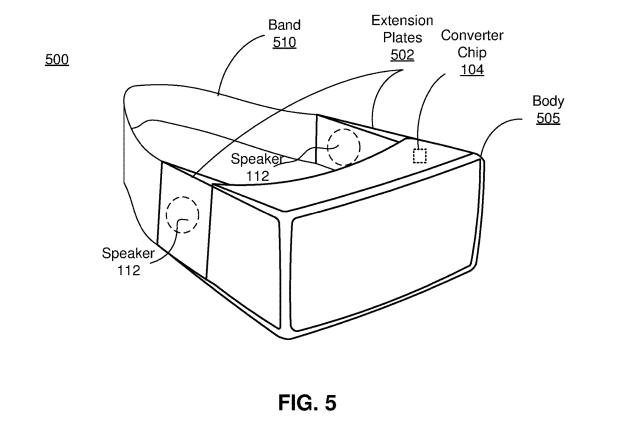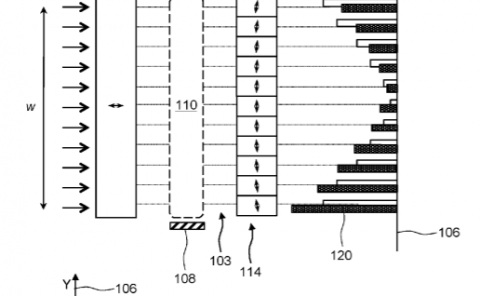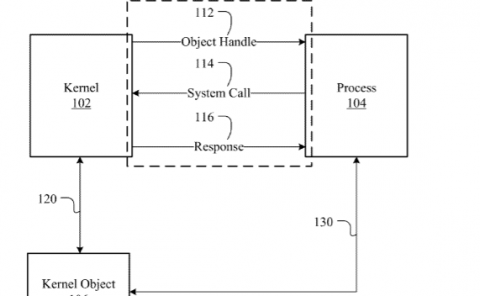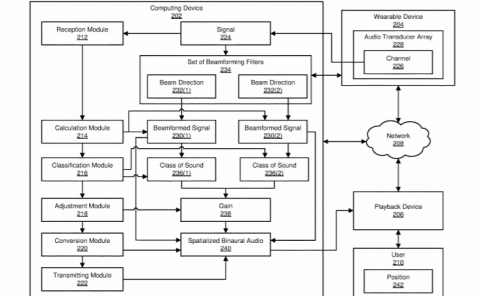Oculus Patent | Over-ear Speaker System For Head-mounted Display Unit
Patent: Over-ear Speaker System For Head-mounted Display Unit
Publication Number: 20180352332
Publication Date: 2018-12-06
Applicants: Oculus VR, LLC

Abstract
An over-ear speaker system for a head mounted display includes a speaker, an impedance detection circuit, and a sound processor. The impedance of the speaker changes according to the temperature of the speaker. The sound processor coupled to the impedance detection circuit receives an impedance signal representing the impedance of the speaker and adjusts the boosting of frequency components in the sound signal based on the impedance signal. The adjusting of boosting of frequency components in the sound signal includes boosting of a frequency range of the sound signal below a resonance frequency of a speaker and may enable the protection of the speaker from damage by adjusting boosting of frequency components near a resonance frequency of the speaker at which maximum excursion of the speaker occurs.
BACKGROUND
This disclosure relates generally to a speaker system in a head-mounted display (HMD), and more specifically to an over-ear speaker system in a HMD with signal boosting functionality.
HMDs typically include speakers or personal audio devices (e.g., headphones and in-ear headphones or earbuds) to provide sound to users. For good sound quality, speakers included in an HMD require a large resonance chamber for boosting of low frequencies. Thus, including speakers in an HMD typically result in the HMD having a larger volume and size, an inconvenience to the user. While a personal audio device such as earbuds may provide a lightweight and compact solution for providing sound to an HMD user, this solution provides a barrier for users to share the HMD because users typically prefer not to share their own personal audio device due to hygiene reasons.
SUMMARY
Embodiments relate to an over-ear speaker system for use in an HMD that adjusts boosting of frequency components in a sound signal based on detecting of impedance across input terminals of the speakers, the impedance representing a resonance frequency of the speaker changing due to fluctuations in temperature of the speaker. The adjustment of frequency components includes increasing a boosting of frequencies in a first frequency range of the sound signal below the resonance frequency of the speaker to enhance the low frequency bass of the sound signal. The adjustment of frequency components can also include decreasing a boosting of frequencies in a second frequency range of the sound signal including a resonance frequency of the speaker to prevent damage to the speaker. The speaker system includes an impedance detection circuit and a sound processor. The speaker has input terminals to receive a sound signal. A resonance frequency of the speaker changes based on the temperature of the speaker. The impedance detection circuit detects the impedance across the input terminals of the speaker that changes according to the temperature of the speaker. The sound processor is coupled to the impedance detection circuit and receives an impedance signal representing the impedance of the speaker. The sound processor adjusts boosting of frequency components in the sound signal based on the impedance signal.
In one embodiment, the impedance detection circuit detects the impedance across the input terminals by detecting a voltage across the input terminals and current in one of the input terminals. The impedance detection circuit may include a sense resistor having an end connected to the one of the input terminals of the speaker, and the impedance detection circuit determines the current in the one of the input terminals by detecting voltage across the sense resistor.
In one embodiment, the impedance detection circuit includes a first analog to digital converter connected to the sense resistor to receive the voltage across the sense resistor and sends a digital version of the voltage across the sense resistor to the sound processor (the voltage across the sense resistor is used to calculate to the current through the speaker) and a second analog to digital converter detects a voltage across the input terminals of the speaker and sends a digital version of the voltage across the input terminals of the speaker to the sound processor. With both the current through the speaker and voltage across the speaker, the impedance can be calculated. The sound processor computes the impedance across the input terminals of the speaker by dividing the voltage across the input terminals of the speaker by the current in the one of the input terminals.
In one embodiment, the sound processor boosts frequency components in the first frequency range of the sound signal below the resonance frequency of the speaker. The sound processor may also decrease a boosting of frequency components in the second frequency range of the sound signal including a resonance frequency of the speaker.
In one embodiment, the decrease or the increase of the boosting is performed while sound is being produced by the speaker.
In one embodiment, the sound processor boosts frequency components in a first frequency range of the sound signal below a threshold frequency. The threshold frequency may be the resonance frequency plus or minus an offset. The sound processor adjusts the threshold frequency by increasing a threshold frequency responsive to an increase of the resonance frequency and decreasing the threshold frequency responsive to a decrease of the resonance frequency.



